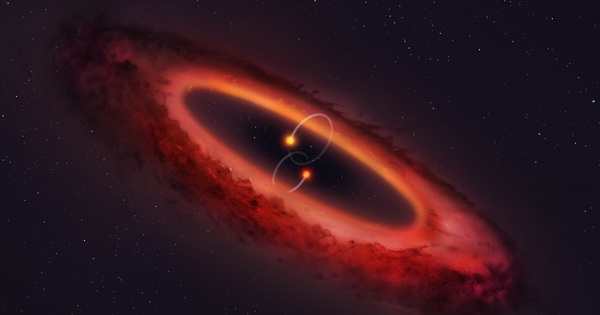Astrophysicists from Northwestern University and the University of California, San Diego (UC San Diego) have found the most compact ultracool dwarf binary system ever seen.
Due to their near proximity, the two stars orbit each other in less time than one day on Earth. In other words, the “year” of each star is only 20.5 hours long.
The recently found system, designated LP 413-53AB, is made up of two ultracool dwarfs, a subclass of very low-mass stars that are so cool that they radiate most of their light in the infrared, rendering them completely invisible to the human eye. Despite this, they are among the most prevalent star kinds in the universe.
Only three short-period ultracool dwarf binary systems, all of which are quite young—up to 40 million years old—had previously been discovered by astronomers. Although LP 413-53AB is thought to be billions of years old, or about the same age as our sun, its orbital period is at least three times shorter than that of any other ultracool dwarf binaries that have been found so far.

The study’s principal investigator, Chih-Chun “Dino” Hsu of Northwestern University, remarked, “It’s fascinating to discover such an extreme system. Although we were aware that these systems should exist in theory, they had not yet been discovered.
At a press conference for the 241st Meeting of the American Astronomical Society in Seattle, Hsu will discuss this research. On Tuesday, January 10, a presentation titled “Discovery of the shortest-period ultracool dwarf binary” will be presented as part of a session on “Stars and Their Activity.”
Hsu is a postdoctoral scientist at Northwestern’s Weinberg College of Arts and Sciences who studies physics and astronomy. He is also a part of the university’s Center for Interdisciplinary Exploration and Research in Astrophysics (CIERA). He started this research while pursuing his doctorate at UC San Diego, where Professor Adam Burgasser served as his advisor.
While investigating archival data, the team made its initial discovery of the peculiar binary scheme. Hsu created an algorithm that uses a star’s spectral data to simulate it. Astrophysicists can ascertain a star’s chemical makeup, temperature, gravity, and rotation by analyzing the light the star emits. This analysis also demonstrates the star’s radial velocity or the rate at which it moves toward and away from the observer.
Hsu found an oddity while looking at the LP 413-53AB’s spectral data. Hsu thought there was just one star in the system because early observations caught it when the stars were closely aligned and their spectral lines overlapped. However, as the stars migrated in their orbit, the spectral lines separated into pairs and underwent opposite-direction shifts. Hsu found there were in fact two stars entangled in a close binary.
At the W.M. Keck Observatory, Hsu made the decision to see the event for himself using big telescopes. The scientists focused the telescopes on the binary system, which is located in the constellation Taurus, on March 13, 2022, and they watched it for two hours. Following that, they made more observations in July, October, and December.
“We could notice things shifting during a couple of minutes of observation when we were performing this measurement,” Burgasser added. “Most of the binary stars we monitor have yearly orbital periods. Consequently, you are measured every few months. After some time has passed, you can put the puzzle together. We were able to watch the spectral lines separate in real time using this method. Observing events in the universe take place in our time is astounding.”
The observations supported the predictions made by Hsu’s model. About 1% of the distance between the Earth and the sun separates the two stars. These stars would have been stacked on top of one another when they were young, roughly one million years ago, according to Burgasser.
The team hypothesizes that the stars may have moved closer one another as they developed or that they may have merged after the ejection of a third, now lost, star. To verify these theories, more observations are required.
Hsu added that academics can discover more about potentially hospitable worlds beyond Earth by examining similar star systems. Any worlds having liquid water on their surfaces—a necessary component to create and maintain life—would need to be much closer to ultracool dwarfs since they are fainter and dimmer than the sun. The habitable zone distance for LP 413-53AB, however, also happens to be the same as the star orbit, rendering the formation of habitable planets in this system unlikely.
These extremely cool dwarfs are our sun’s neighbors, according to Hsu. “It’s helpful to start with our neighborhood neighbors in order to find possibly livable hosts. However, there could not be many livable worlds to be identified if tight binaries are typical among ultracool dwarfs.
Hsu, Burgasser, and their team are working to identify other ultracool dwarf binary systems to complete the data sample needed to adequately investigate these circumstances. Theoretical frameworks for the genesis and evolution of binary stars may be strengthened by new observational data. Finding ultracool binary stars, however, has remained a difficult task up until now.
These systems are uncommon, according to Chris Theissen, Chancellor’s Postdoctoral Fellow at UC San Diego and research co-author. “However, we are unsure if their rarity stems from their rarity of occurrence or from our inability to locate them. That is a broad question. Now that we have a single data point, we may begin to expand. This information had been stored in the archives for a while. We can look for more binaries like this using Dino’s program.”
















